Pierantonio Mezzastris came from a family of artists: he was the nephew of Paolo Nocchi, and thus the great nephew of the painter Vagnozzoro (Noccuro) Meccastra (died after 1388). His young sister, Onofria married Bartolomeo di Tommaso in ca. 1442, and his son Bernardino Mezzastris, also became an artist.
He was first documented in his father’s will in 1457 and last documented in 1500 in the will of his wife, Sibilia. he seems to have died in ca. 1506.
Foligno
Works in the Pinacoteca Civica
The following are in Room 1 of the Pinacoteca Civica:
Coronation of the Virgin (1486)
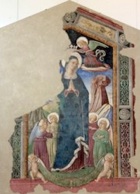
St Jerome as a cardinal and as a penitent (late 15th century)
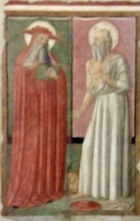
Madonna and Child with saints (1499)
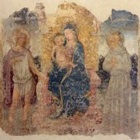
Madonna and Child with St Simon (late 15th century)
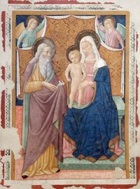
Madonna and Child with saints (late 15th century)
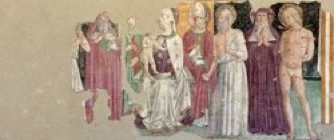
This detached fresco, which is attributed to Pierantonio Mezzastris, came from the Chapter Room of San Francesco. It depicts the Madonna and Child with:
-
✴a lost saint, a fragment of Blessed Peter Crisci, St Jerome as a cardinal and St Catherine of Alexandria on the right; and
-
✴SS Blaise, Jerome as a penitent, Bonaventure and Sebastian on the left.
Madonna and Child and saints (late 15th century)
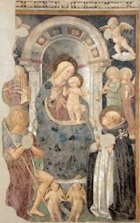
Crucifixion with saints (late 15th century)
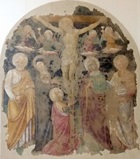
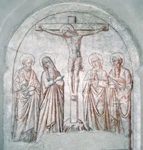
Sinopie, in situ
This damaged detached fresco, which is attributed to Pierantonio Mezzastris, came from the chapel to the right of the presbytery in San Domenico. It depicts the Crucifixion with the Virgin and SS John the Evangelist, Peter, Paul and the kneeling Mary Magdalene. The sinopie survives in the original location; the figures of St Mary Magdalene and of the four angels in the fresco do not appear in the sinopie, which suggests that they were later additions.
Angel of the Annunciation (ca. 1449)
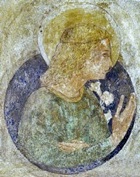
The fresco is attributed to Pierantonio Mezzastris or Benozzo Gozzoli: it is almost certainly based on the cartoon that was used for Benozzo’s fresco in Narni. It has to be said, however, that there is no documentary evidence that Benozzo was ever in Foligno.
Works in Santa Maria Infraportas
The frescoes in Santa Maria Infraportas that attributed to Pierantonio Mezzastris include the following:
St Anne crowned by angels (15th century)
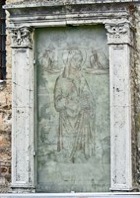
St Roch (15th century)
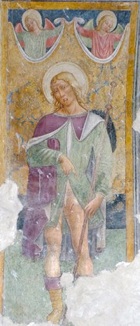
Crucifixion (15th century)
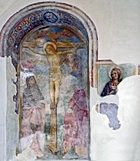
St Jerome with angels (15th century)
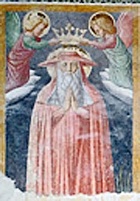
SS Onuphrius (Onofrio) and Roch (15th century)
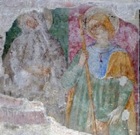
Frescoes (1454-60) in Santa Maria in Campis
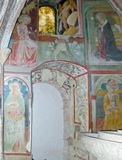
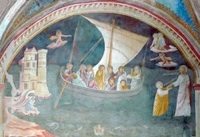
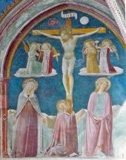
These frescoes in the Cappella della Navicella (1452) in Santa Maria in Campis, which belonged to the merchant di Pietro di Cola della Casse, are usually attributed at least in part to Pierantonio Mezzastris. They include:
-
✴the Annunciation and SS Lucy and Helen on the left wall;
-
✴the Navicella (or Christ walking on the water) on the back wall, which was based on Giotto’s celebrated fresco (ca. 1310) in the atrium of old St Peter’s, Rome; and
-
✴the Crucifixion with the Virgin and SS John the Evangelist and Mary Magdalene on the right wall.
Madonna and Child (1467)
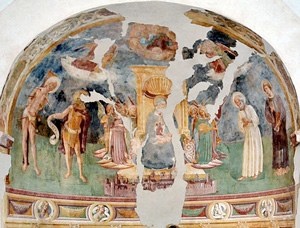

This fresco in the apse of the church of the Madonna della Fiamenga (see the detour from Ponte San Giacomo in Walk I) is signed by Pierantonio Mezzastris and dated by inscription. It depicts the Madonna and Child enthroned, surrounded by musical angels, with the blessing Christ above. Four saints stand to the sides: SS Sebastian and John the Baptist to the left; and SS Jerome and Leonard to the right. There is an interesting cityscape of Foligno below the throne, and busts of sibyls in tondi in the frieze below that.
Maestà Bella (1470)
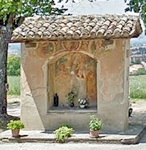
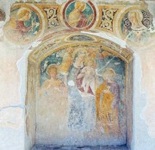
This fresco is in an aedicule at the entrance to the village of Carpello (see Walk III). The signature of Pierantonio Mezzastris, and a record of 1918 gives the date as 1470. The scenes depict:
-
✴Madonna and Child enthroned with SS John the Baptist and John the Evangelist, in the main scene;
-
✴SS Peter and Paul [with what above ??] are depicted on the sides of the niche; and
-
✴the figures of the Annunciation flank Christ blessing in the tondi above.
Madonna and Child with St Lucia and St Claire (1471)
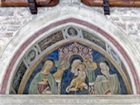
St Roch and the Risen Christ (ca. 1480)
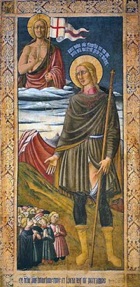
The banner, which is attributed to Pierantonio Mezzastris, depicts St Roch commending the people of Foligno to the Risen Christ.
Madonna and Child with saints (after 1481)
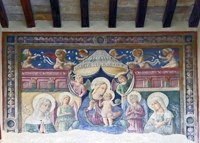
This fresco, which is attributed to Pierantonio Mezzastris, is above the entrance to the nunnery of Sant’ Anna. It was financed from the will (1481) of Elena, the widow of Filippo di Ser Andrea Varini. It depicts the Madonna and Child enthroned with St Anne and the Blessed Angelina, below a cornice with angels throwing flower petals. Unfortunately, the lower part has been lost.
Stigmatisation of St Francis (1487)
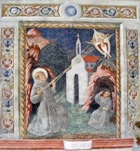
Annunciation (15th century)
This fresco was recorded in an aedicule above the entrance to the nunnery of SS Trinita in Annunziata in 1866, with an attribution to Pierantonio Mezzastris. It was subsequently detached and lost.
Assisi
Frescoes (1477)
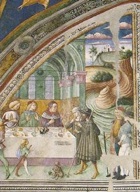
-
✴scenes from the life of St Antony Abbot (on the left wall);
-
✴miracles of St James on the route to Compostella (on the right wall), including the scene illustrated here, which contains a signature;
-
✴the doctors of the Church (in the vaults); and
-
✴two frescoes on the counter-facade:
-
•God the Father with angels; and
-
•St Antony Abbot
Two other frescoes on the counter-facade that featured in in the work commissioned from Pierantonio Mezzastris are generally attributed to Andrea d' Assisi, l' Ingegno or (more recently - see the reference below) to Perugino.
Crucifixion (1482)
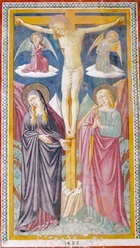
Madonna and Child with angels (15th century)
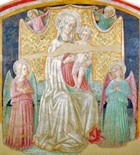
Bevagna
Crucifixion (15th century)
This fresco fragment in San Vincenzo, which was probably destroyed in 1986, was attributed to the young Pierantonio Mezzastris. A surviving black and white photograph depicts the crucified Christ with angels,with St John the Evangelist and a bishop saint (presumably St Vincent) to the right. A lady on the left presumably supported a figure of the swooning Virgin that had been lost by the time that the photograph was taken.
Montefalco
Maestà dei Bennati (15th century)
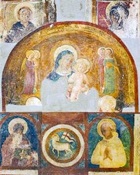
-
✴The main fresco depicted the Mother and Child enthroned with two pairs of musical angels. The lower part of the fresco, which seems to have included two standing saints, no longer survives.
-
✴The three figures now mounted below, which came from the archivolt, depict SS Antony Abbot and Bernardino of Siena, with a tondo of the Agnus Dei between them.
-
✴The figures now mounted above the main scenes, which originally belonged to standing figures to the sides, depict SS Antony of Padua and Clare of Montefalco. Again, only the upper parts survive
The work is attributed to Pierantonio Mezzastris, based on its similarity to the signed Maestà Bella in an aedicule near Carpello, outside Foligno (see above).
Fresco Fragment (15th century)
This fragment of a fresco of the Madonna and Child with angel in Sant’ Agostino is attributed to Pierantonio Mezzastris.
Narni
Frescoes (ca. 1470)
Cardinal Berardo Eroli probably commissioned the important fresco cycle that covers the walls of what is now the Eroli Chapel, San Francesco. The signature of Pierantonio Mezzastris was identified on the steps in the fresco of the dream of Pope Innocent III in the early 20th century, but it is no longer visible.
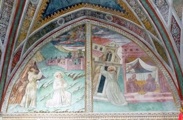
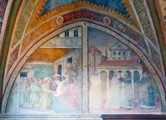
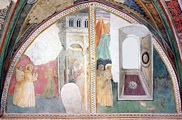
The cycle comprises
-
✴six scenes from the life of St Francis:
-
•St Francis liberates Arezzo from devils;
-
•the dream of Pope Innocent III;
-
•Pope Innocent III approves the Franciscan Rule;
-
•meeting of SS Francis and Dominic; and
-
•two miracles of St Francis; and

-
✴two scenes from the life of St Bernardino of Siena, to whom the chapel was dedicated:
-
•St Bernardino before the Bishop of Siena (the future Pope Eugenius IV); and
-
•St Bernardino brings a woman back to life.
[These frescoes seem to have been inspired by similar frescoes in San Francesco, Montefalco by Benozzo Gozzoli (scenes from the life of St Francis) and Jacopo Vincioli (scenes from the life of St Bernardino).]
Madonna and Child with angels and saints (ca. 1470)

This damaged fresco, which came from the lunette of a portal of the church of San Girolamo, is now in the Pinacoteca, together with the decorative frescoed cornice of the composition. The main scene, which depicts the Madonna and Child with SS Francis and Jerome, is attributed to Pierantonio Mezzastris. Cardinal Berardo Eroli, who financed the restoration of San Girolamo in 1465-71, probably commissioned these frescoes, at the same time that he commissioned those in what is now the Eroli Chapel, San Francesco (see above).
Pietà with SS Sebastian and Francis (15th century)
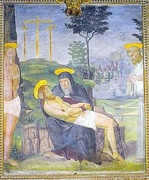
Spello
Frescoes (ca. 1498)
These frescoes in the portico of San Girolamo, which are attributed to Pierantonio Mezzastris, depict:
-
✴the Blessed James of the Marches holding a vial of the Holy Blood of Christ (dated 1498 in the inscription along the bottom that also identifies the Blessed James); and
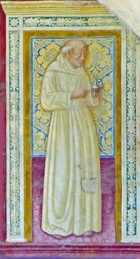
-
✴St Francis receiving the stigmata (on the right, above the arch that leads to the cemetery and the convent).

Trevi
Fresco fragments (1488)
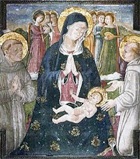
Cornice of a Processional Standard (ca. 1478)
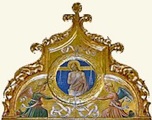
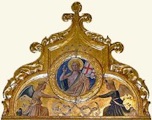
This double-sided cornice was documented in 1872 in the hospital in the ex-convent of San Domenico and is now in the Pinacoteca. Each side has an image of Christ in a tondo with two angles below: the Crucified Christ is on one side and the Risen Christ is on the other. The cornice probably belonged to a processional banner, and the fact that the Crucified Christ is depicted with two whips makes it likely that it had belonged to a penitential confraternity. The cornice is attributed to Pierantonio Mezzastris, and may well have been commissioned after the outbreak of plague in Trevi in 1478.
Sources in the 18th century document a gilded cornice with an image of the Crucified Christ above a panel of the Assumption of the Virgin on the altar of the now-demolished church of Santa Maria della Piaggia, which belonged to the penitential Confraternita di Santa Maria della Piaggia. This was probably the side of cornice illustrated above, to the left.
If this link is correct, it is possible to reconstruct the history of the cornice before 1872. The likelihood is that, when Santa Maria della Piaggia was abandoned, the possessions of the confraternity passed to the Compagnia della Misercordia, who administered the hospice at San Giovanni Decollato. These goods would have been moved again to the new hospital at San Domenico in 1817. At some point in this tortuous history, the main panel of the Assumption of the Virgin (which was probably also double-sided) must have been lost.



